❑The Inventory Listing (Grid) Report provides a complete list of the Values and Quantities of Inventory Items - based on the the "As Of Date" selected and the customized columns, order, format, and filters you've set (explained below).
•Understanding the Cost and Value columns on the Inventory Listing Report:
✓The various Quantities listed on this report are those that are maintained by the Inventory Tracking System as Inventory Items and are tracked as follows:
▪Inventory Used in Job Costing (see the Inventory and related sub-chapters in the Job Costing section of the Help Files)
▪Ordered (see the Purchase Orders chapter)
▪Purchased (see the Vendor Bills chapter)
▪Sold (see the Invoices chapter)
✓The various Values represent the Average Inventory Cost Inventory Valuation Method when your Company will be using the STARK 35 General Ledger System) in the Sale-Purchase Items Form for each Inventory Item listed.
▪These reported Inventory Item Values are based on the currently selected Inventory Valuation Method (i.e., Average Inventory Cost).
•To access the Inventory Listing Listing (Grid) Report:
a)From the Backstage Menu System Select Reports then Choose Inventory Reports and Select the Inventory Listing (Grid) option, or
b)From the Quick Access Menu, Select Reports then Choose Inventory Reports and Select the Inventory Listing (Grid) option
.png)
Inventory Listing As Of report Grid
•Options - The only Options are:
✓As Of Date - Initially this is set as Today but may be changed as needed.
▪Use the Drop-Down Calendar/Date provided to Choose a different As Of Date.
✓Retrieve Data - Click on this Icon to populate the Inventory Listing Grid based on the As Of Date entered above.
✓Print, Export and Email options work in the normal way (see below).
•Columns - Select which columns of data are to be displayed:
-columns.png)
✓Click the asterisk (¬) at the left of the data grid's Header row (see the mouse pointer in the illustration above) to display a list of all of the column names - and associated data - which may be displayed.
✓By default, all Column Names will be Checked.
✓Remove the Check mark (Click on the Check to remove it) to hide that column of data from the data grid.
•Setting the Order in which the data in the grid is Listed within the Inventory Listing (Grid) (Report):
✓The default sorted order of the Inventory Listing (Grid) List is based on the Item - which is ordered from lowest to highest (1 - 9, a-z, then A - Z).
✓Thereafter, the column that determines the sorted order of the List may be easily changed, whenever needed.
-header-resortbycolumn.png)
Inventory Listing (Grid) - Data Grid sorted by Inventory Value - highest to lowest
✓To do so:
▪Click another column's Header Name (the mouse points to the sorting arrow within the Balance Header Name in the illustration above) to change the sorted order to by on that column of data, with the sorted order automatically set from lowest to highest (a-z or 1 - 9).
▪To change this newly selected column's sorted order from highest to lowest, Click that column's Header Name again.
▪An Arrow next to the Header Name indicates the column that is determining the sorted order of the Grid Data.
o~ indicates lowest to highest (a-z or 1 - 9)
o€ indicates highest to lowest (z-a or 9-1).
•Print - Print - Once you have:
a)Chosen which columns of data are to be included,
b)Set the order in which they are to be listed, related any columns (if appropriate),
c)Adjusted any column's width,
d)Filtered the data as appropriate (see the "Creating various Custom Filters for the Inventory Listing (Grid) dialog's data grid. " discussion below).
e)Then, you are ready to Print the resulting Inventory Listing (Grid) Report.
✓Click the Print Icon at the top of the Form to display the Print Preview dialog.
-printpreview.png)
✓The Print Preview dialog will be displayed exactly as the data grid was formatted.
✓It is easy to Close the Print Preview, make formatting adjustments (if needed), then Click the Print Icon again until you have the Inventory Listing (Grid) report displayed in the Print Preview dialog exactly as needed.
✓The example below illustrates how an Inventory Listing (Grid) Report may ultimately be customized, formatted and printed (or exported as a PDF file).
•Export - Once the data has been formatted, filtered, sorted and configured as needed, a copy of this report data may also be Exported, if required.
✓Click the Export Icon to display the standard Windows® Save As dialog.

✓Folder Location - The last folder location used will be chosen, but this may be changed, as needed.
✓File name: - By default, the file name inserted will be to form name plus a date string with year, month, day, and time but this may be changed, as appropriate.
✓Save as type: By default, this will be XLS but may also be changed as needed.
✓Save - Click the Save option to export the data to the designated file name, type and location.
•EMail - Once the data has been formatted, filtered, sorted and configured as needed, Click the EMail Icon to send this data as a PDF attachment to an Email address of your choosing.
❑Creating various Custom Filters for the Inventory Listing (Grid) dialog's data grid.
•Filtering the data that will be displayed in the grid:
✓Once the specific columns that are to be displayed have been chosen, and the sorted order in which those columns will be listed is set, then one or more additional filters may be applied to the listed data, if desired.
![]()
•Special Selection - Click the Special Selection Icon (see mouse pointer next to the Inventory Value header name illustrated above) associated with that column's Header Name to display its associated Drop-Down Selection List
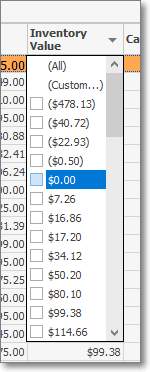
✓The List will contain the available options available for that column's Header Name
✓The List that is presented contains each item in that column (in this case, each Inventory Value Amount)
✓In the example above, the Balance column will contain the list of available Amounts and a Check Box is positioned next to each Amount
✓Check each Amount that is to be included.
✓Any remaining un-checked Amounts will disappear from the Form's data grid.
•Sometimes the User may need a more refined method to Choose which Data will be included in the Inventory Listing (Grid) Form's data grid.
✓In this Inventory Listing (Grid), you might want to eliminate Inactive Inventory Items and those items identified a Kits from the Grid to get a more accurate view of the "real" Inventory Items currently in use..
✓To accommodate this need, the Special Selection Icon's Drop-Down Selection List (see illustration above) also offers a "(Custom...)" option.
-filters.png)
✓This Custom Filter option is available whenever the Special Selection Icon is displayed - which is anytime the mouse pointer is positioned over a Header Name in the Grid - and is accessed by Clicking that Icon and then Choosing the (Custom...) option.
✓See the "Creating a Custom Filter for the List, a Group, and/or Grid Data Detail" discussion in the Grids & Lists chapter for more information.
•When the Custom Filter option is selected, the Custom Filter dialog is displayed.
✓The first filtering choice is "Show rows where" with the selected Header Name shown below.
✓If a previously defined Special Selection was entered for the selected column (as was documented and illustrated above), that Header Namet will be entered automatically as shown below.
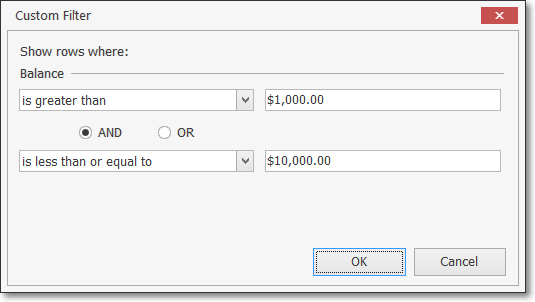
✓To (re-)define this initial filtering criteria, the User is requested to quantify how the selected column's data should compare to a value (or a different field) in one or two situations (e.g., one comparison, an OR comparison, or an AND comparison).
•Using the illustration below (unrelated to the illustration above and based on a column containing Dates rather than Amounts) as a training example, let's assume the User needs to see Subscribers Last Payment

✓Using the first Drop-Down Selection List the User would choose the first "comparative" phrase from the list provided.
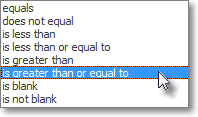
▪Then, the User would enter the value to be compared, and because the system knows it will be a Sale's Date, it offers a Drop-Down Calendar/Date Entry field from which a Date may be chosen.
▪Next, the AND button is selected (by default) - but this may be changed, if appropriate; or ignored if no additional comparison is needed (e.g., any Payment Dated on or after 10/01/2015 would be acceptable)
▪Assuming a comparison is needed (it would be in this case), use the second Drop-Down Selection List to choose the other "comparative" phrase from the list provided.
▪Finally, the User would enter the other value to be compared, and because the system knows it too will be a Payment Date, it offers a Drop-Down Calendar/Date Entry field from which a Date may be chosen.
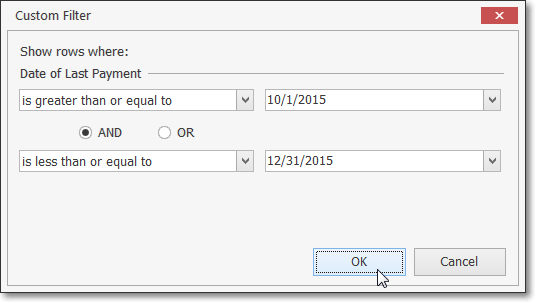
✓Click OK and the Custom Filter is implemented.
•When a Custom Filter is active, that Filter Criteria is displayed at the bottom of the Grid.
✓The User may Check and un-check the Filter Criteria box (see hand pointer in the illustration below) to quickly see the data differences when the filter is active, or inactive
![]()
✓To Cancel the Custom Filter, Click on the Close box on the bottom left side of the Filter Criteria line (see mouse pointer in the illustration above) and that Custom Filter will be canceled.
•Enhancing the Custom Filter:
✓Once defined, a Custom Filter may be further refined or expanded by Clicking the "Customize..." button at the bottom right side of the Filter Criteria line (see illustration immediately above).
✓The Filter Builder dialog will be displayed with the original Custom Filter information already inserted, plus any additional customized filter you enter.
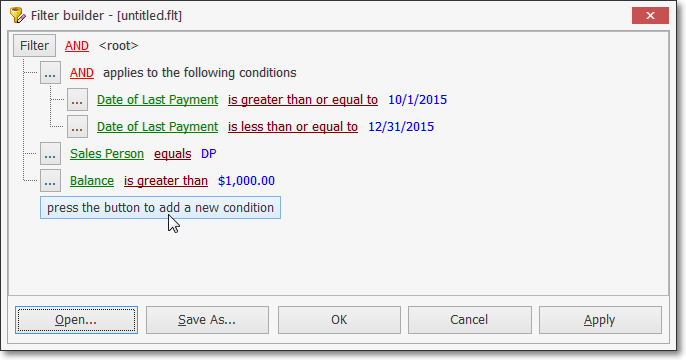
✓press the button to add a new condition - Click this button bar to insert a new filter line
▪By default, the first field name in the Header will be displayed (i.e., Subscriber ID).
▪Click that Subscriber ID field name to open a Drop Down Selection List of all available field names.
▪Choose the desired field name and it will replace the original default Vendor ID field name.
▪equals will be the default logic name displayed next to that field name.
▪Click that equals logic name to open a Drop Down Selection List of all available logic names.
▪Choose the desired logic name
▪Enter the appropriate condition Value.
✓Repeat this process as needed to define the filter that is needed.
✓Save - If you will need to use this exact filter again, Click the Save As... button and name this filter.
✓Apply - To implement this filer, Click the Apply button.